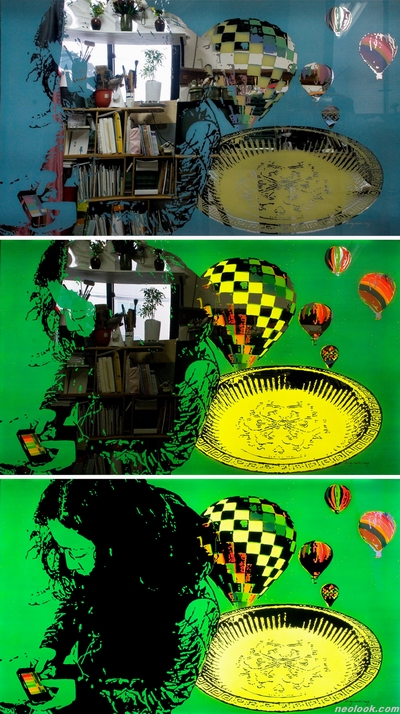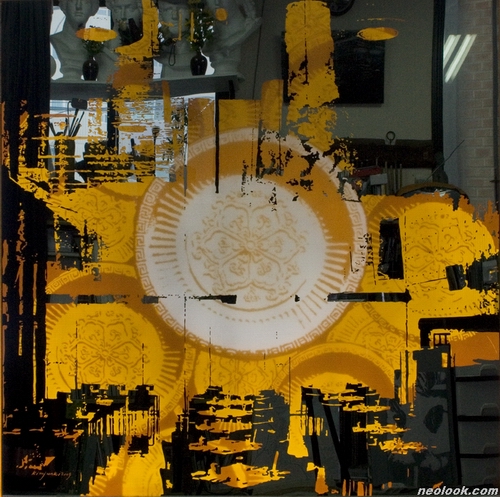- ● homepage
- ● archives
- ● restoration
- ● books
- ● big banners
- ● post board
- ■ neo's search
- ■ about us
- ■ 게재방법 안내
- 개인정보처리방침

- [email protected]
- Tel. 02_335_7922
- Fax. 02_335_7929
- 10:00am~04:30pm
- 월요일~금요일
- 3/3(월) 대체공휴일

Seen City
김준기展 / KIMJUNKI / 金埈基 / installation 2009_0311 ▶ 2009_0317
● 위 이미지를 클릭하면 네오룩 아카이브 Vol.20070620d | 김준기展으로 갑니다.
초대일시_2009_0311_수요일_06:00pm
벨벳 인큐베이터 연례공모 프로그램
후원_한국문화예술위원회-아르코 영아트 프론티어 프로그램 협찬_(주)자산 유리-보오미 거울_(주)조양 글라스
관람시간 / 12:00pm~08:00pm / 마지막 날 화요일(17일)은 낮 12시까지
벨벳 인큐베이터 VELVET INCUBATOR 서울 종로구 팔판동 123-3번지 Tel. +82.2.736.7023 www.velvet.or.kr
아날로그적 감성의 회복을 희구하는 디지털 시대의 도시인의 초상 ● 김준기는 현대적 삶의 대부분을 구성하고 있는 도시의 생태와 그 속에서 생활하는 인간의 모습에 관심을 갖고 이를 관찰하며 작업해왔다. 김준기에게 도시는 자신의 창작의 근거지이자 생활과 사색의 일부분이지만 그 공간은 관찰과 분석의 대상으로서의 객체화된 공간이 되기도 한다. 작가는 그러한 도시에 몸담고 생활하며 관찰하고 사색하는 과정을 거쳐 작품을 잉태해낸다. 그렇지만 도시에서 생활하며 작품의 모티브를 채집하면서도 작가는 항상 스스로 도시 공간의 주체로서 그 속에서 타자와 관계를 맺고 호흡하는 자신을 들여다보기보다는 도시 공간에서의 삶을 객관적으로 바라보는 관찰자로서 일정한 거리를 두고 대상을 바라보는 편이다. ● 도시를 구성하는 특징 가운데 하나라고 볼 수 있는 현대식 건물이나 지하철과 버스와 같은 대중교통 수단의 유리창과 거울을 매개로 생성되는 반사와 투영의 이미지들이 오늘날의 도시공간에 넘쳐난다. 그들의 중첩과 간섭에 관심을 가지고 이러한 이미지들을 화면에 담는 작업을 해온 김준기가 이번에 초점을 두는 것은 좀 더 정리된 화면이며, 그 화면 속에 색채를 보다 적극적으로 적용시킨 이미지들의 조형성이다. 이제까지 그의 화면에는 거대도시의 전형적인 상징인 고층 건물과 자동차 등이 인파와 뒤섞인 모습이 드러나기도 하고 때로는 그 도시의 이면의 소소한 모습이 인상적으로 표현되기도 하였었는데 이번 전시에서는 전자보다는 후자에 초점이 맞춰져 있는 셈이다.

- 김준기_Seen City 0910_Silver Mirror, Sheet, LED, Light Box, 고분자수지 접합_120×71.1cm_2009 △ Light Off / ▽ Light On / ▽▽ Light On
김준기는 자신에게 순간적으로 다가온 이미지들을 중첩시켜 구성된 화면 안에서 존재 간의 관계와 사고에 주목하고 자신의 작품을 바라보는 관람자의 입장에 따라 가변적으로 해석될 수 있는 열려진 태도를 보여주었었다. 이번 전시에 출품된 작품들이 이전의 전시에 출품되었던 작품들과 일관된 맥락을 유지하면서도 차이를 보이는 점이 있다면 그것은 작가가 이전보다 도시 공간의 외형적인 이미지에 대한 관심을 줄이고 그보다는 도시에서 생활하는 사람들의 모습과 행동을 통해 그들의 내면을 읽는 데에 더욱 관심을 쏟고 있다는 점이다. 그의 작품의 특징은 지극히 평범한 시선으로 바라본 도시의 단상이 화면에 중첩되어 다층적 이미지의 변주와 하모니를 만들어낸다는 것이다. ● 김준기는 작품의 주제에서 일관성을 유지하는 만큼 작품 재료에 있어서도 일관되게 유리와 거울을 주요 재료로 다루고 있다. 작가는 작품 활동 초기부터 유리와 거울 등을 중요한 재료로 사용하여 왔는데, 거울은 원래 자아성찰의 도구이면서 때로는 허영의 상징이었으나 그의 작품에서의 거울은 자아와 대상을 비추고 서로를 엮어내는 표현과 기록의 마당이며 실제와 그 허상으로서의 그림자, 그리고 다시 그 허상의 반사와 중첩이 이루어지는 다중적 의미와 관계를 형성시켜주는 장으로서 인식되고 있다. 김준기가 다루는 이미지는 반사와 투사를 거치면서 현실과 가상의 경계를 모호하게 만들고 결과적으로 자아 정체성의 혼란을 유발하는 현대인의 초상을 보여주는데, 이번 작품에서 김준기는 이러한 정체성의 혼란을 현대인의 좌절과 이에 따른 일회성 소비와 욕망의 반복적 현상으로 연결하여 해석한다. ● 이번 전시에 출품된 작품에서 김준기는 유리와 거울이라는 재료를 LED 발광 패널과 시트지 등과 결합시켜 보다 미묘하고 독창적인 이미지를 만들어내고 있다. 작가가 그의 작품에서 도입하고 있는 거울과 유리는 현대적이면서도 차가운 속성을 가졌으며 시각적 표현 소재로 가공하기가 어렵고 자칫하면 산산이 깨져버릴 수도 있는 재료인데, 작가는 이러한 민감하고 다루기 힘든 재료적 속성에도 불구하고 유리에 대한 탐구를 계속 해나가고 있다. 이러한 유리에 날카로운 칼로 컷팅한 시트지로 표현된 이미지와 포토샵 처리된 디지털 이미지를 바탕으로 작가가 직접 그린 이미지들을 중첩시켜 작품이 완성된다. 이렇게 제작된 작품에 배후로부터의 조명을 가미하여 조명이 켜진 상태에서 나타나는 이미지와 조명이 꺼진 상태에서 드러나는 이미지 사이에는 표면 반사와 이미지 투과의 정도가 달라짐으로써 한 작품 안에서 복수의 이미지가 담기게 된다. 이렇게 가변적인 이미지를 보여주는 것은 작가의 표현을 따르자면 도시 공간에서 활동하는 현대인의 실상과 욕망의 한계를 극대화시켜 제시함으로써 궁극적으로 그들이 새로운 자아의 성찰에 이르게 하려는 것이다.

- 김준기_City-holic 0909_Silver Mirror, Sheet, LED, Light Box, 고분자수지 접합_106.7×60.8cm_2009 ◁ Light Off / ▷ Light On

- 김준기_Seen City 0908_Silver Mirror, Sheet, LED, Light Box, 고분자수지 접합_106.7×60.8cm_2009 ◁ Light Off / ▷ Light On
김준기의 작품은 재료적 차별성과 함께 주제 면에서도 몇 가지 특징을 보여준다. 우선 그의 작품 속의 인물이나 오브제들은 관람객과 적극적으로 소통하려는 의지를 드러내지 않는다. 그럼으로써 도시의 익명성과 개체간의 단절 등의 감정이 잘 드러난다. 이번에 그의 작품 속에 등장하는 인물들의 대부분도 지하철이나 공원같은 공공의 장소에서 외부와의 소통을 단절시킨 채 휴대전화나 게임기와 같은 디지털 기기를 손에 든 상태에서 그곳에 몰두하며 시선을 집중하고 있는 모습으로 묘사된 작품이 대부분을 이룬다. ● 김준기가 포착한 인물들은 대부분 익명성을 띤다. 그리고 이러한 인물들은 이미지와 컨텐츠를 소비하는 현대사회의 주체로서 도시 공간에서 군중 속의 소외를 느끼며 디지털 이미지가 만들어 내는 허구적 현실에 소모적으로 매몰되어가는 모습으로 묘사되고 있다. 그러한 이미지에서 작가는 현대인들의 기대와 좌절, 긴장된 삶에서의 피난처로서의 가상의 공간에 대한 탐닉 등을 읽고 있으며 그러는 가운데 관람자들이 자신이 속한 공간의 의미와 존재감을 확인하고 자신을 그 속에 투영시켜 바라보도록 만든다. 그리고 이러한 모습을 통해 작가는 현대적 도시문화가 역설적으로 상기시켜주는 아날로그적 감성의 회복을 희망하고 있다. ■ 하계훈

- 김준기_Seen City 0913_Silver Mirror, Sheet, LED, Light Box, 고분자수지 접합_90×90cm_2009_Light On
우리가 세상을 바라보는 방식은 각자의 가치관과 이해를 포함하고 있다. 보는 것은 선택이며 이 선택에 따라 우리가 보는 것을 이해 할 수 있듯이 이번 작업에서 나의 시선은 이미지가 현실을 대신하는 시대, 이미지와 콘텐츠를 소비하는 도시에 살고 있는 현대인에게 고정되어 있다. 이번 작업에서 주목하는 것은 표피적이고 현상적인 현실의 모습 속에서 자기애정과 자기유희에 몰입된 디지털 세대의 소비와 욕망, 그리고 그것의 일회성에 관한 것들을 생각해보는데 있다. 디지털 홀릭 상태의 현대인들을 관찰하고 탐구하는 과정에서 출발하여 확대된 이번 작업이 디지털화 되어가는 현대인의 삶속에서 나타나는 욕망의 한계와 일회적 속성을 확인하고 자각할 수 있는 기회가 되길 희망한다. ■ 김준기

- 김준기展_벨벳 인큐베이터_2009

- 김준기展_벨벳 인큐베이터_2009
An urban dwellers pursuit to redeem analog appreciation in a digital era ● The works of Jun-Ki Kim are observations of inhabitants in modern cities and their lifestyles. The urban scene is not only origin of his creations where he lives and contemplates, but it is a space that he perceives and decomposes. His creations are incubated by observing and contemplating the city in which he resides. Although his motives are gathered from dwelling in the city, rather than identifying himself as the urbanite that breathes and socializes, he objectively observes urban life from a distance. ● The reflective and refractive properties of mirror and glass object are commonly observed phenomena on modern buildings and public transportations, such as subways and buses. While Jun-Ki Kim's earlier work focused on recreating this reiteration and intervention, it has recently shifted on refining composition and applying intense colors to this idea. His previous works would vary from images of skyscrapers with busy streets to insightful images of insignificant incidents which were impressively conveyed. The contents of his current work focus on the later of the two styles. ● Jun-Ki Kim contemplates on the relationship and incidents that occur when overlaying the images that abruptly approach him and show openness towards various interpretations that are expressed by spectators. While maintaining the underlying approach from his previous exhibition, his current exhibition shows less interest on the external contour of the city and more concern on understanding the innate mind of individual urbanites. An acknowledgeable note of his work is the variable and harmony he creates by overlaying images from a practical point of view. ● Jun-Ki Kim shows consistency in his selection of theme and materials as his use of mirror and glass extends to his earliest works. Although the mirror is commonly conceived as self-reflection and sometimes vanity, Jun-Ki Kim perceives it as a tool to associate 'self' with 'subject' to display a setting where reality, illusion, and the overlay of illusive reflections coexist. His works dissolve the boundaries between reality and conception by exploiting reflective and refractive materials to reveal the modern urbanite and his/her disoriented identity. In his most recent work, Jun-Ki Kim interprets the disorientation of identity as the result of a repetitive cycle between the modern city dwellers' frustration, compulsive spending, and desire. ● Jun-Ki Kim's work from a current exhibition, which combines glass and mirror with LED panels and sheet paper, creates an elegant and unique effect. The mirror and glass materials he adopted educe impressions of both modernism and bleakness, and his exploration of these materials continues despite the painstaking fabrication process and delicate internal property. A complete piece of work comprises of overlaying the glass with neatly cut sheet paper and his original hand drawn image. A light is projected from the rear of the completed work to create an illusion of multiple images resulted by the reflecting and refracting properties of the composing materials. The artist explains that the display of variable images is to bestow self reflection by stretching the boundaries of desire and standpoint of the modern urbanite. ● Jun-Ki Kim's selection of materials for his work is unique and his themes have notable characteristics. The individuals and objects in his work do not actively communicate with the spectator. The anonymity of the city remains and he shows suspended emotions among characters. Most characters in his work are shown in public settings, such as subways and parks, but their attention is confided to digital devices, such as cell phones and portable game devices, alienating themselves from their surroundings. ● Most of Jun-Ki Kim's characters are anonymous people who represent the modern urbanites consumption of images and contents. They are portrayed as feeling alienated among a crowd and their time consumed in virtual reality with digital images. The artist enables the spectator to recognize and comprehend the space he/she is associated in by identifying the expectations and setbacks of the modern urbanite and his/her indulgence in virtual reality to escape strenuous existence. The intent of the artist is to redeem analog appreciation by conveying the absurdity of modern urban culture through these portraits. ■ HAKYEHOON
We perceive the world based on our principles and understandings. As we can choose to see what we wish and we can understand that which we have seen, I have set my eyes on an era where an image can replace reality and where modern urbanites consume images and contents. My work will venture only skin deep observing reality to contemplate the consumption, desire, and its compulsive expenditure in the digital era of self-affection and self-gratification. This project that began by observing and analyzing the condition of digital addiction hopes to achieve realization and confirmation of the desires and compulsions emerging as an aftermath of digitalization. ■ KIMJUNKI
Vol.20090308a | 김준기展 / KIMJUNKI / 金埈基 / installation

